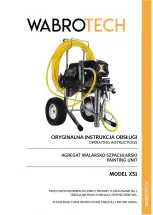
GB
4
Important:
The bayonet lock must be properly
latched whenever you transport the pressure
sprayer. Also, the spray lance should be in the
holder provided for the purpose (Fig. 4).
Screw in the pump again (clockwise) until it is
tight.
Screw the feed funnel back onto the bottom of
the pressure sprayer.
Turn the pump grip slightly counter-clockwise in
order to release it from the bayonet lock.
Pressure is built up in the tank with pumping
movements (up and down) of the pump handle.
The tank pressure at any given moment can be
read off the pressure gauge (Fig. 3/Item 7). The
maximum tank pressure (operating pressure)
must not exceed 3 bar. The overpressure valve
(Fig. 3/Item 6) triggers at a positive pressure of 3
bar and relieves any pressure exceeding this
amount.
To spray, press the trigger lever (Fig. 1/Item 3)
on the spray gun handle.
The spray jet will stop immediately you let go of
the trigger lever.
You can direct the spray precisely at even hard-
to-reach areas by bending the swan-neck (Fig.
1/Item 4) at the joints (Fig. 5).
Clean the sprayer each time after you have used
it and leave it open to dry.
You can prolong the working life of the sprayer
by occasionally applying resin- and acid-free
grease (Vaseline) to the seal rings and collars.
Please note:
Severe stress during transportati-
on, use and storage, negative environmental
factors (at the point of use and storage), and
poor maintenance and care may cause the
sprayer to suffer premature wear. Each time
before you use the sprayer it is important, there-
fore, to check that it is in safe and good opera-
ting condition and that there are at least no visi-
ble signs of external damage.
We recommend that you arrange for a specialist
or Service Center to check whether the sprayer
is still safe for operation as soon as you discover
any defects with a potentially negative effect on
safety and at least every 5 years.
Maintenance
Prior to performing any maintenance work on the
unit, always relieve the pressure via the over-
pressure valve (Fig. 3/Item 6) by raising the over-
pressure valve. Be sure to observe the safety
instructions.
To change the pump membrane, pull up the
pump lever as far as it will go, turn it counter-
clockwise until you come against notable resi-
stance, and then turn it a little further counter-
clockwise until the cover plate and the bayonet
separate (Fig. 6/Item A).
Press the membrane plate (Fig. 7/Item 11) out of
its holder, insert a new membrane and lubricate
it with acid-free grease.
After using the unit and prior to performing any
maintenance work, always relieve the pressure
by simply pulling up on the funnel-shaped knob
connected to the safety/overpressure valve (Fig.
6/Item A).
Anleitung GLDS 5 GB 16.12.2004 9:57 Uhr Seite 4




























